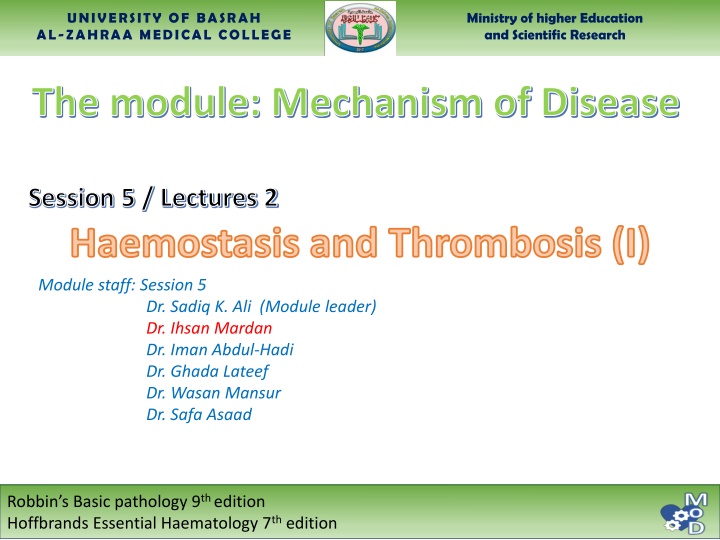Haemostasis and Thrombosis (I)
Thrombosis, a critical aspect of haemostasis, involves the formation of blood clots within vessels due to factors like endothelial injury and disrupted blood flow. Endothelial dysfunction and abnormal flow patterns contribute to the pathogenesis of thrombosis, leading to various complications. Understanding these mechanisms is crucial in managing thrombotic disorders and preventing adverse outcomes.
Download Presentation

Please find below an Image/Link to download the presentation.
The content on the website is provided AS IS for your information and personal use only. It may not be sold, licensed, or shared on other websites without obtaining consent from the author.If you encounter any issues during the download, it is possible that the publisher has removed the file from their server.
You are allowed to download the files provided on this website for personal or commercial use, subject to the condition that they are used lawfully. All files are the property of their respective owners.
The content on the website is provided AS IS for your information and personal use only. It may not be sold, licensed, or shared on other websites without obtaining consent from the author.
E N D
Presentation Transcript
UNIVERSITY OF BASRAH AL-ZAHRAA MEDICAL COLLEGE Ministry of higher Education and Scientific Research The module: Mechanism of Disease Session 5 / Lectures 2 Haemostasis and Thrombosis (I) Module staff: Session 5 Dr. Sadiq K. Ali (Module leader) Dr. Ihsan Mardan Dr. Iman Abdul-Hadi Dr. Ghada Lateef Dr. Wasan Mansur Dr. Safa Asaad Robbin s Basic pathology 9th edition Hoffbrands Essential Haematology 7thedition
UNIVERSITY OF BASRAH AL-ZAHRAA MEDICAL COLLEGE Ministry of higher Education and Scientific Research Session 5 Lecture 2 Thrombosis
UNIVERSITY OF BASRAH AL-ZAHRAA MEDICAL COLLEGE Ministry of higher Education and Scientific Research Learning objectives: 1. Haemostasis; Definition Balance of coagulant and anticoagulant factors Intrinsic and extrinsic pathways Role of platelets Fibrinolytic system 2. Thrombosis; Definition Predisposing factors Effects of thrombosis Outcomes
2- THROMBOSIS The pathologic counterpart of haemostasis is thrombosis, the formation of blood clot (thrombus) within intact vessels. The three primary abnormalities that lead to thrombus formation (Virchow s triad): (1) endothelial injury, (2) stasis or turbulence of blood flow, and (3) blood hypercoagulability
Endothelial Injury Endothelial injury is an important cause of thrombosis, particularly in the heart and the arteries (e.g., thrombi in the cardiac chambers after myocardial infarction) Dysfunctional endothelium (hypertension) elaborates greater amounts of procoagulant factors (e.g., platelet adhesion molecules, tissue factor, PAI) and synthesizes lesser amounts of anticoagulant molecules (e.g., thrombomodulin, PGI2, t-PA).
Alterations in Normal Blood Flow Turbulence thrombosis by causing endothelial injury or dysfunction, as well as by forming countercurrents and local pockets of stasis; stasis is a major contributor to the development of venous thrombi. contributes to arterial and cardiac Hyperviscosity syndromes (such as polycythemia) increase resistance to flow and cause small vessel stasis; the deformed red cells in sickle cell anemia cause vascular occlusions, and the resultant stasis also predisposes to thrombosis.
Hypercoagulability It is loosely defined as any alteration of the coagulation pathways that predisposes to thrombosis, and it can be divided into primary (genetic) and secondary (acquired) disorders. Hypercoagulability contributes infrequently to arterial or intracardiac thrombosis but is an important underlying risk factor for venous thrombosis.
Morphology Thrombi can develop anywhere in the cardiovascular system (e.g., in cardiac chambers, on valves, or in arteries, veins, or capillaries). The size and shape of a thrombus depend on the site of origin and the cause. Thrombi are focally attached to the underlying vascular surface and tend to propagate toward the heart; thus, arterial thrombi grow in a retrograde direction , while venous thrombi extend in the direction of blood flow.
Thrombi can have grossly (and microscopically) apparent laminations called lines of Zahn; these represent pale platelet and fibrin layers alternating with darker red cell rich layers. Such lines are significant in that they are only found in thrombi that form in flowing blood. Their presence can therefore usually distinguish antemortem thrombosis from the nonlaminated clots that form in the postmortem state.
Arterial thrombi are typically relatively rich in platelets, as the processes underlying their development (e.g., endothelial injury) lead to platelet activation. Venous thrombi (phlebothrombosis) frequently propagate some distance toward the heart that is prone to give rise to emboli.
Venous thrombosis is largely the result of activation of the coagulation cascade, and platelets play a secondary role. Because these thrombi form in the sluggish venous circulation, they tend to contain more enmeshed red cells, leading to the red, or stasis, thrombi. The veins of the lower extremities are most commonly affected (90% of venous thromboses). Thrombi on heart valves are called vegetations.
Fate of the Thrombus Propagation. Embolization.. Dissolution. Organization and recanalization.
Fate of the Thrombus Propagation: The thrombus enlarges through the accretion of additional platelets and fibrin. Embolization: Part or all of the thrombus is dislodged and transported elsewhere in the vasculature. Dissolution: If a thrombus is newly formed, activation of fibrinolytic factors may lead to its rapid shrinkage and complete dissolution.
Fate of the Thrombus With older thrombi, extensive fibrin polymerization renders the thrombus substantially more resistant to plasmin-induced proteolysis, and lysis is ineffectual. Therapeutic administration of fibrinolytic agents is not effective unless given within a few hours of thrombus formation. Organization and recanalization: Older thrombi become organized by the ingrowth of endothelial cells, smooth muscle cells, and fibroblasts into the fibrin-rich thrombus.

